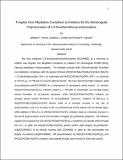Tungsten Oxo Alkylidene Complexes as Initiators for the Stereoregular Polymerization of 2,3-Dicarbomethoxynorbornadiene
Author(s)
Forrest, William P.; Axtell, Jonathan Clayton; Schrock, Richard Royce
DownloadText-4-16-14-final.pdf (1.069Mb)
PUBLISHER_POLICY
Publisher Policy
Article is made available in accordance with the publisher's policy and may be subject to US copyright law. Please refer to the publisher's site for terms of use.
Terms of use
Metadata
Show full item recordAbstract
We have employed 2,3-dicarbomethoxynorbornadiene (DCMNBD) as a monomer to explore new tungsten oxo alkylidene complexes as initiators for stereoregular ROMP (ring-opening metathesis polymerization). The initiators include MAP (monoaryloxide pyrrolide) oxo alkylidene complexes with the general formula W(O)(CHCMe[subscript 2]Ph)(Me[subscript 2]Pyr)(OAr) (Me[subscript 2]Pyr = 2,5-dimethylpyrrolide, OAr = an aryloxide) and W(O)(CHCMe[subscript 2]Ph)(OR)[subscript 2] (OR = an aryloxide or OC(CF[subscript 3])[subscript 3]), or PPh[subscript 2]Me or CH[subscript 3]CN adducts thereof. We have found that MAP initiators yield cis,syndiotactic-poly(DCMNBD) as a consequence of stereogenic metal control. In contrast, W(O)(CHCMe[subscript 2]Ph)(OR)[subscript 2](L) initiators (where L = PPh[subscript 2]Me or acetonitrile) are strongly biased toward formation of cis,isotactic structures, while W(O)(CHCMe[subscript 2]Ph)(OR)[subscript 2] initiators are strongly biased toward formation of cis,syndiotactic structures. Addition of B(C[subscript 6]F[subscript 5])[subscript 3] to W(O)(CHCMe[subscript 2]Ph)(Me[subscript 2]Pyr)(OR) species leads to a dramatic increase in the rate of polymerization and to an increase in the cis,syndiotacticity of the polymer (if not already high), while addition of B(C[subscript 6]F[subscript 5])[subscript 3] to W(O)(CHCMe[subscript 2]Ph)(OR)[subscript 2] initiators leads to a dramatic increase in the rate of polymerization and to the formation of highly cis,syndiotactic polymers. All evidence supports the proposal that 16e W(O)(CHCMe[subscript 2]Ph)(OR)[subscript 2](L) complexes can operate either through loss of L to yield 14e W(O)(CHCMe[subscript 2]Ph)(OR)[subscript 2] species (which yield largely cis,syndiotactic-poly(DCMNBD)) or by directly reacting with DCMNBD to yield an 18e intermediate and largely cis,isotactic-poly(DCMNBD). All polymerizations by W(O)(CHCMe[subscript 2]Ph)(OR)[subscript 2](L) and W(O)(CHCMe[subscript 2]Ph)(OR)[subscript 2] initiators are proposed to operate through some version of chain end control.
Date issued
2014-04Department
Massachusetts Institute of Technology. Department of ChemistryJournal
Organometallics
Publisher
American Chemical Society (ACS)
Citation
Forrest, William P., Jonathan C. Axtell, and Richard R. Schrock. “Tungsten Oxo Alkylidene Complexes as Initiators for the Stereoregular Polymerization of 2,3-Dicarbomethoxynorbornadiene.” Organometallics 33, no. 9 (May 12, 2014): 2313–2325.
Version: Author's final manuscript
ISSN
0276-7333
1520-6041